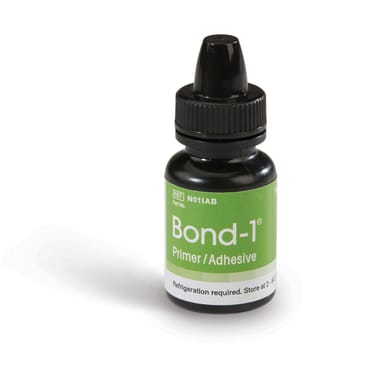Request More Info

Bond-1
Pentron Clinical
Bond-1, builds on the company’s 18-year history of clinical success developing bonding systems. When Pentron first introduced Bond-1 in 1996, the company was successful in marketing this new generation to clinicians, because it is just as effective as the older fourth generation products such as Bond-It, the company’s popular, multi-step bonding agent.
Faster and Easier As esthetic, bonded restorations became more of the norm in dentistry, there was a demand for simplified bonding procedures. Pentron’s goal in creating Bond-1 was to address these market needs and make adhesive dentistry faster and easier for the clinician. The company reduced the procedure time by combining the primer and adhesive steps into a single bottle. These single-bottle, total-etch bonding agents came to be known as fifth-generation products. Bond-1 proved to be just as effective as fourth-generation products, and it boasted bond strengths up to 31 MPa to dentin and 27 MPa to enamel. Today, Bond-1 is one of Pentron’s most successful products, and it has received the American Dental Association’s Seal of Acceptance. In addition to addressing the needs of esthetic dentistry, Pentron also realized there was still a need for bonding amalgam restorations. AmalgaCure, sold separately as part of the Bond-1 system, is a 2- part resin system used to enhance and simplify bonding of amalgam to dentin. Although Bond-1 was already compatible with dual-cure materials, Pentron added a dual-cure activator to the product, alleviating apprehension voiced by some clinicians. They were concerned that the fifth-generation products would not work with dual-cure resins when an activator was not supplied. The dual-cure activator is sold as part of the kit or as a refill.
Unique Features and Advantages Bond-1 combines primer and adhesive into one bottle, saving the clinician several steps and valuable time throughout the bonding procedure. Bond- 1’s unique features separate it from the other products in its category.Bond-1 creates the ideal sealed surface and interpenetrated network of polymerized primers and unfilled resin, resulting in a high bond with a low film thickness of only 8 ?m. Its low film thickness ensures the fit of indirect restorations.
Bond-1 can be used with dual-cure resins.
The versatility of Bond-1 allows it to bond to direct or indirect, light- or chemical-cured composites, porcelains, metal restorations, and amalgam to tooth structure.
Bond-1 is available in both an acetone- and alcohol-based formula.
Bond-1 C&B, the alcohol-based formula, offers the necessary working time required for large surface area bonding, which is indicated for crown- and-bridge bonding procedures.
Bond-1 eliminates postoperative sensitivity and minimizes microleakage. Indications Bond-1 is suitable for all direct and indirect restorations including composite, amalgam, crowns, bridges, inlays, onlays, and cores. It can be used in bonding to substrates including porcelain, ceramic, and metal. Bond-1 also can be used for desensitization of dentin. A total-etch technique, with 37% phosphoric acid, must be used in conjunction with Bond-1. The material will self-cure in indirect applications when used in conjunction with the company’s resin cements, including Cementit Universal C&B Resin Cement and Breeze Self-Adhesive Resin Cement, without the use of the dual-cure activator. Pairing Bond-1 with Pentron’s resin cements is also ideal for bonding both fiber and metal posts, including FibreKleer and FibreKor Posts.
Pentron’s goal was to make adhesive dentistry easier and faster. Bond-1 combines primer and adhesive into one bottle, saving the clinician several steps and valuable time throughout the bonding procedure.
High Ratings and Positive Reviews Bond-1 has received high ratings from clinicians evaluating the product. In a critique by 16 dentists who used Bond-1 in 720 procedures, the product received a 96% clinical rating,4 and every dentist reported that Bond-1 was easy to use, required fewer steps, and was easy to adapt to the office routine.4 Product instructions and packaging also received high ratings. No bond failures were reported during the 3- month evaluation period. Most of the dentists stated that they would purchase Bond-1, and 92% would recommend it to their colleagues.4 They favorably reviewed the gel etchant, which is the traditional blue color, less viscous, and with less chroma, making it fairly transluscent.4 With years of proven clinical benefits behind it, Bond-1 offers clinicians a great choice—a tested top-quality product at a reasonable price. —Jackie Syrop
References Heymann H.Dental adhesive know-how. Dental Products Report. 2008;October:107- 110. 2. El-Ehaideb A, Mohammed H. Shear bond strength of “one bottle” dentin adhesives. J Prosthet Dent. 2000;84:408-412. 3. Leinfelder KF. A critical evaluation of a fifth generation dentin adhesive. On file, Pentron Clinical Technologies, Wallingford, CT. 4. The Dental Advisor Plus. Bond-1 +++++. Vol l7, No. 1 (Jan/Feb) 1997.
View Product

